

Partner Abby Adeline Manning, buried together
Queer Places:
92 Mt Vernon St, Boston, MA 02108, USA
Piazza della Trinità dei Monti, 15, 00187 Roma RM
Studio Building, 110 Tremont St, Boston, MA 02108
Whitney Farm, 476 North Rd, Shelburne, NH 03581, Stati Uniti
Mount Auburn Cemetery, 580 Mt Auburn St, Cambridge, MA 02138, Stati Uniti
.jpg) Anne
Whitney (September 2, 1821 – January 23, 1915) was an American sculptor and
poet. She made full-length and bust sculptures of prominent political and
historical figures, and her works are in major museums in the United States.
She received prestigious commissions for monuments. Two statues of Samuel
Adams were made by Whitney and are located in Washington, D.C.'s National
Statuary Hall Collection and in front of Faneuil Hall in Boston. She also
created two monuments to Leif Erikson. A certain homoeroticism emerged, made
all the more remarkable by the fact that many prominent artists of this
era—including Thomas Eakins,
F. Holland Day,
John Singer Sargent,
Harriet Hosmer,
Edmonia Lewis, and
Anne Whitney—had intense romantic
attachments with members of their own sex.
Anne
Whitney (September 2, 1821 – January 23, 1915) was an American sculptor and
poet. She made full-length and bust sculptures of prominent political and
historical figures, and her works are in major museums in the United States.
She received prestigious commissions for monuments. Two statues of Samuel
Adams were made by Whitney and are located in Washington, D.C.'s National
Statuary Hall Collection and in front of Faneuil Hall in Boston. She also
created two monuments to Leif Erikson. A certain homoeroticism emerged, made
all the more remarkable by the fact that many prominent artists of this
era—including Thomas Eakins,
F. Holland Day,
John Singer Sargent,
Harriet Hosmer,
Edmonia Lewis, and
Anne Whitney—had intense romantic
attachments with members of their own sex.
The community of talented women in Rome included artists whose lives and works have become well known in art-historical circles: Harriet Hosmer, Edmonia Lewis, Anne Whitney, and Vinnie Ream; and those whose reputations have remained (until now) buried in the historical record: Emma Stebbins, Margaret Foley, Sarah Fisher Ames, and Louisa Lander. In 1903, Henry James immortalized this community of American women sculptors in Rome by characterizing them as “that strange sisterhood of American lady sculptors who at one time settled upon the seven hills [of Rome] in a white marmorean flock.” Hosmer, Lander, Stebbins, and Foley, under the mentorship of the thespian Charlotte Cushman, formed a close-knit and supportive community (though not without personal and professional jealousies) that the author Nathaniel Hawthorne rendered with some sympathy in his romantic account of American artists in Rome, The Marble Faun (1860).
Whitney made works that explored her liberal views regarding abolition, women's rights, and other socials issues. Many prominent and historical men and women are depicted in her sculptures, like Harriet Beecher Stowe. She portrayed women who lived ground-breaking lives as suffragists, professional artists, and non-traditional positions for women at the time, like noted economist and Wellesley College president Alice Freeman Palmer. Throughout her adult life, she lived an unconventional, independent life and had a lifelong relationship with fellow artist, Abby Adeline Manning, with whom she lived and traveled to Europe.
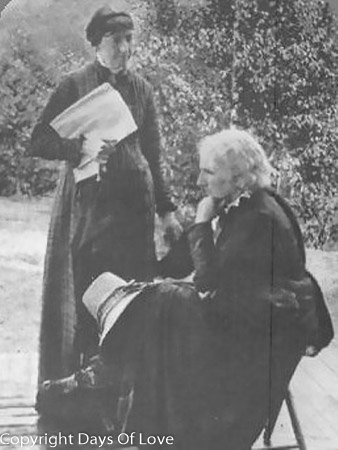
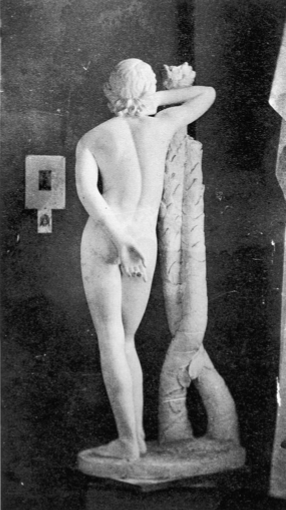
Anne Whitney, The Youth (Dream of Love or Boy with a Palm), ca. 1862–63, now
lost. Photograph dated ca. 1862–67, courtesy of the Wellesley College
Archives, Papers of Anne Whitney.
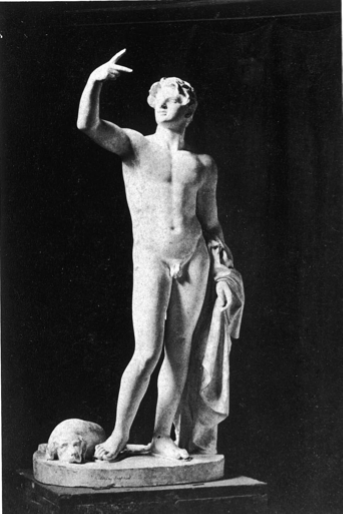
Anne Whitney, Chaldean Shepherd, 1862, first version now lost. Photograph
courtesy of the Wellesley College Archives, Papers of Anne Whitney.
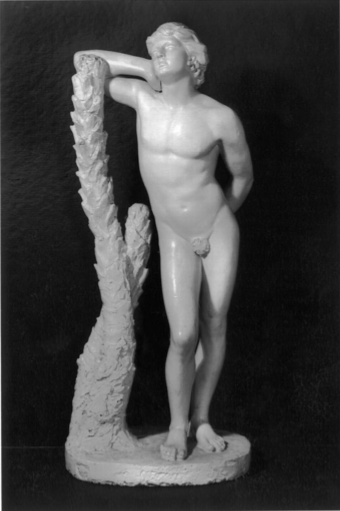
Anne Whitney, Lotus Eater, 1868, plaster, 35 ¼ × 15 ¼ × 12 ¼ in. Collection of
The Newark Art Museum, gift of Mr. and Mrs. Hugh S. Hince, 1963, 63.75.
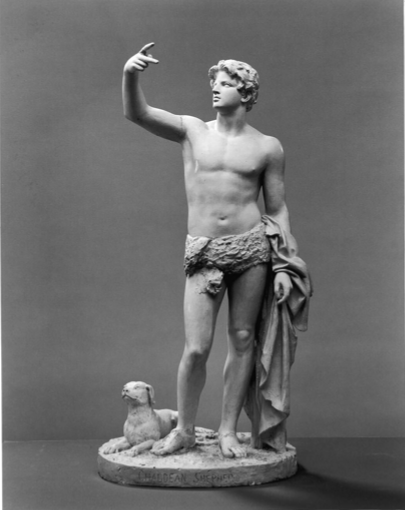
Anne Whitney, The Chaldean Shepherd, ca. 1868, plaster, 34 × 15 ½ × 14 5/8 in.
Smith College Museum of Art, Northampton, Mass., gift of Mrs. Hugh Stratton
Hince (Marion L. Stone, class of 1913), SC1967:50.
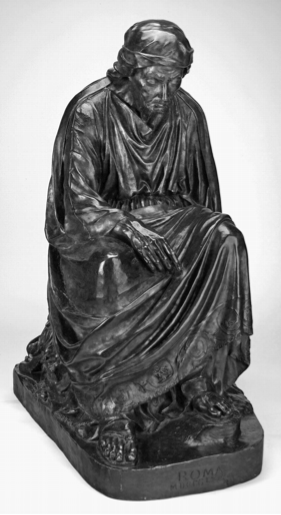
Anne Whitney, Roma, 1869, bronze, 27 × 15 ½ in. Davis Museum and Cultural
Center, Wellesley College, Wellesley, Mass., gift to the college by the class
of 1886.
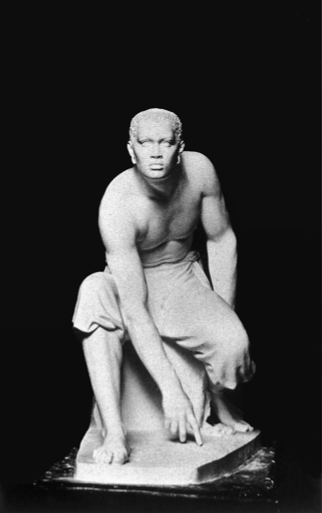
Anne Whitney, Toussaint L’Ouverture in Prison, 1869–71, now lost. Photograph
courtesy of the Wellesley College Archives, Papers of Anne Whitney.
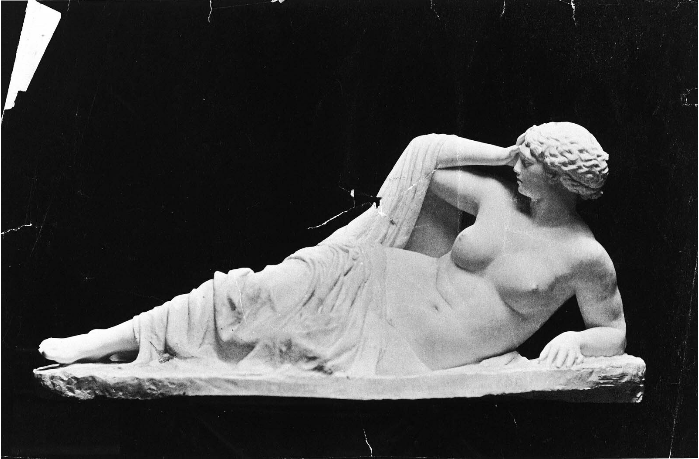
Anne Whitney, Ethiopia Shall Soon Stretch Out Her Hands to God, or Africa,
1862–64, plaster, destroyed. Photograph courtesy of the Wellesley College
Archives, Papers of Anne Whitney.
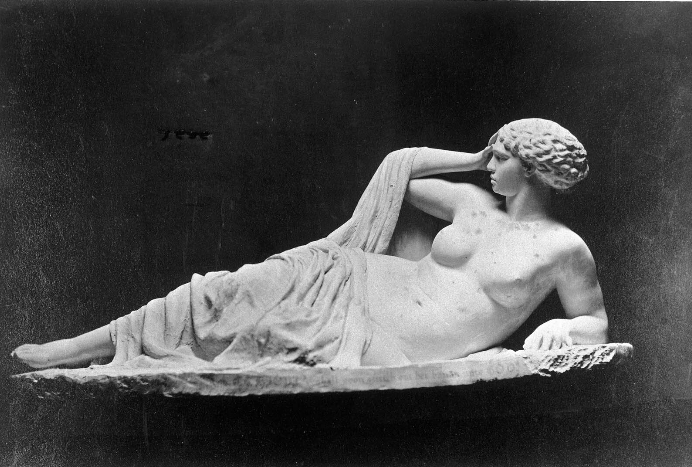
Anne Whitney, Ethiopia Shall Soon Stretch Out Her Hands to God, or Africa,
reworked 1865–66, plaster, destroyed. Photograph courtesy of the Wellesley
College Archives, Papers of Anne Whitney.
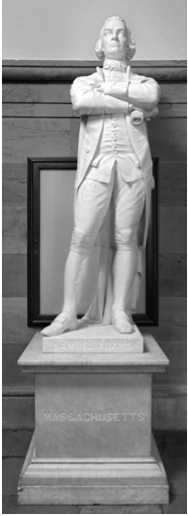
Anne Whitney, Samuel Adams, 1876, marble, height 7 ft. 8 in. U.S. Capitol.
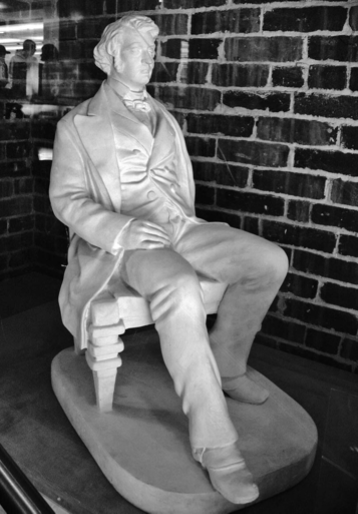
Anne Whitney, Charles Sumner Memorial, 1876, plaster model. Watertown Free
Public Library, Watertown, Mass.
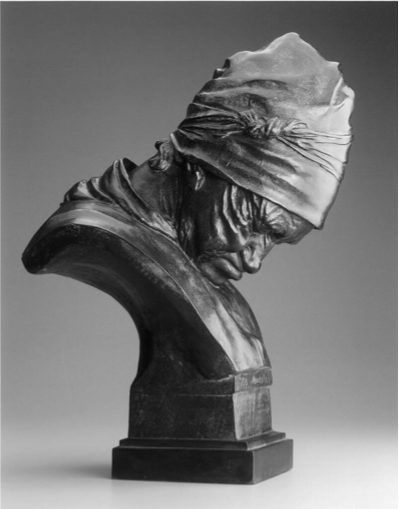
Anne Whitney, Le Modèle, 1875, bronze, 18 ½ × 9 ¾ × 12 ½ in. Museum of Fine
Arts, Boston, gift of Mrs. Maria Weston Chapman, 85.423. Photograph © 2014
Museum of Fine Arts, Boston.
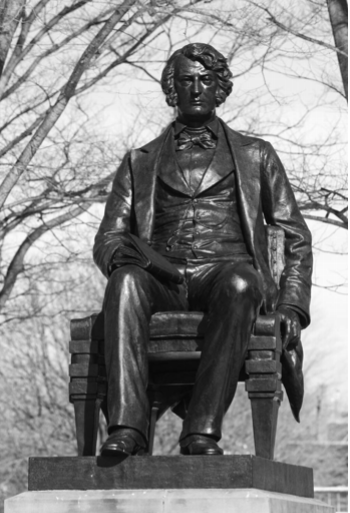
Anne Whitney, Charles Sumner Memorial, 1900, bronze. Cambridge Commons,
Cambridge, Mass.
92 Mt. Vernon Street
Mount Auburn Cemetery, Cambridge, MA
Anne Whitney was born in Watertown, Massachusetts on September 2, 1821.[1] She was the youngest child of Nathaniel Ruggles Whitney, Jr.—a justice of the peace— and Sally, or Sarah, Stone Whitney, both of whom were descendants of Watertown settlers of 1635. She had a sister and five brothers. The family moved to East Cambridge by the time that Whitney was 12 years old and returned to Watertown in 1850.[2] Her family were Unitarians and abolitionists.[2] They fought for women's and education rights, as well as abolition of slavery.[3]
Except the 1834–1835 school year that she attended at a private school run by Mrs. Samuel Little in Bucksport, Maine,[2] she received her education from private tutors.[1] Her year at private school allowed her to teach.[4] Whitney enjoyed writing poetry and had an interest in sculpture.[1] Whitney and her family were engaged in the rich artistic, musical, and literary life of the Boston area; they were also politically active and dedicated to abolition and women’s suffrage. Her support of the suffrage movement, and her friendship with many of the women who were driving forces behind it, may explain her determination to take alternative paths in her own life. Rather than marrying and raising children (the average age of marriage was about 23 for women at the time) she focused on developing her creative abilities. She wrote poetry in the romantic tradition of Samuel Taylor Coleridge, John Keats, and Percy Bysshe Shelley, and often quoted their verses, along with those of other poets, in her correspondence. Her first and only book of poems was published in 1859, and it earned limited though lasting critical acclaim; a second edition, published in 1906, included only a few changes.
Throughout her adulthood, she was an advocate for forest conservation, women's rights, abolition of slavery, and equal educational opportunities for African-Americans.[2] Whitney was an individualist, who lived independently and cut her hair short, which annoyed her Victorian neighbors.[29] She wrote of her independent nature in one of her poems, "You are welcome, world, to criticize, carp and croak yourself hoarse if you will."[3] She was active in political, literary and artistic circles[12] and supported liberal activists, sculptors and other artists, entertaining people like Harriet Hosmer and Edmonia Lewis and her home.[29] One of her friends and supporters was writer Annie Adams Fields, who found her to be a "noble, simple, strong living woman.[26]
Shortly before her book was published, Whitney made the unconventional decision to become a sculptor. She received advice from Thomas Ball, Henry Kirke Brown, Erastus Dow Palmer, and William Rimmer in these early years, learning from each one and constantly improving her abilities. She also studied anatomy in a Brooklyn hospital. There is little evidence of her first efforts beyond occasional comments in her correspondence and contemporary biographies. By 1859 she exhibited marble busts of her parents (now lost) at the Boston Art Club, and in 1860 she exhibited a bust of the toddler Laura Brown (Smithsonian American Art Museum, Washington, DC) at the National Academy of Design in New York. That same year she went to Philadelphia for several months to attend lectures at the Pennsylvania Academy of the Fine Arts, the only institution then offering formal instruction to women, and to draw from its cast collection with a friend from Salem, the painter Fidelia Bridges.
Whitney turned her attention to sculpture in 1859, at the age of thirty-eight. She studied anatomy at a Brooklyn hospital and took her first art courses at the Pennsylvania Academy of the Fine Arts in 1860. The beginning of Whitney’s sculpture career coincided with the beginning of her most important relationship. While in Brooklyn she boarded at the home of her brother’s friend Richard Manning and met Manning’s daughter, the aspiring painter Adeline or Addy Manning. They soon formed the kind of bond that became known as a Boston marriage, a term especially popular in New England to describe two women in a stable, usually cohabiting relationship in which they were financially and emotionally dependent on each other, rather than on men. The term came into use in the late nineteenth century following the publication of Henry James’s novel The Bostonians (1885), where the relationship between Olive and Verena became the standard representation of one of these long-term unions. Whether these relationships—and there were a significant number in Whitney’s intellectual and cultural circles—were sexual or not is unclear, and not necessarily relevant. Of greater importance was the freedom they gave women to live the lives they wanted, outside of masculine control.
Between 1862 and 1864, she studied with the eccentric doctor-turned-sculptor William Rimmer, who taught anatomy and modeling in Boston. Encouraged by the successful careers of the women sculptors in Rome, Whitney pushed the boundaries of artistic production in the United States, producing two extraordinary male nudes between 1862 and 1867. One of Whitney’s male nudes, a life-size marble figure, was originally entitled The Youth (also known as Dream of Love and Boy with a Palm). Reminiscent of both the Faun of Praxiteles and Stebbins’s Lotus Eater, Whitney’s figure stood in an exaggerated contrapposto, leaning one elbow against the trunk of a palm tree. The other arm was placed behind the figure’s back. The pose allowed the body to be on full display. Whitney later confided to her friend the abolitionist Maria Weston Chapman that she and her friends jokingly referred to the sculpture as “The Boy and the Palm.”
In Boston, she also modeled a statuette of the Chaldean Shepherd in 1862, an ancient figure who practiced an early form of astronomy while tending his flocks at night. Between 1862 and 1864, she produced her life-sized allegorical work, Ethiopia Shall Soon Stretch Out Her Hands to God, or Africa, in response to the Emancipation Proclamation, which President Lincoln had first drafted in the summer of 1862. Whitney looked to several sources for her revolutionary new image of emancipation. She used her nineteen-year-old friend, the painter Elizabeth Howard Bartol, as a model. She may have discussed this artistic project with the legendary abolitionist Harriet Tubman and likely used her appearance as inspiration for Ethiopia’s stylized hair. And she no doubt had read Stowe’s famous words about Sojourner Truth in the Atlantic Monthly.
Edmonia Lewis met Anne Whitney in 1864, when they both worked in Boston’s Studio Building on Tremont Street. Like Lydia Maria Child, Whitney publicly supported Lewis’s sculptural career. Whitney seemed genuinely puzzled by this young woman—by her mixed Native American and black identity. “Edmonia is very much of an aboriginal,” she wrote to her partner, Abby Manning, “grateful, vengeful, a little cunning, and not altogether scrupulous about the truth when dealing with those she doesn’t love; open, kind and liberal as day with those she does. I like her in spite of her faults, and will help her all I can.”
By late 1866 or early 1867, Anne Whitney and Abby Manning decided the time had come to move to Rome. Newton friends Mary C. Shannon and her niece, known as Mary Junior, as well as Fidelia Bridges, planned to join them. On February 17, Whitney wrote to Manning in Brooklyn, reporting that she had paid a round of calls to say goodbye to friends and expressing her concern that Bridges’s finances might make it impossible for her to join their party. Bridges and her siblings were orphaned at a young age and she worked as a nanny to support her family. But in the end Bridges did secure the necessary funds, welcome news since she planned to share an apartment and associated expenses with Whitney and Manning in Rome.
Whitney reconnected with sculptor Margaret Foley. Foley began her professional career as a schoolteacher and a textile worker, but trained herself as a sculptor. Before leaving Massachusetts for Rome in 1860 she was close to Whitney and her friends, particularly the painter Ellen Robbins, and while abroad Whitney often sent her family news of the success Foley had carving bas relief portraits and ideal busts for travelers. Whitney and Manning spent much time with Foley and her companion, the English sculptor Elizabeth "Lizzie" Hadwen. Shortly after arriving in Rome Whitney met painter sisters Mary Elizabeth and Abigail Osgood Williams from Salem, best known as the Misses Williams. The sisters moved to Italy in 1861 and remained abroad until 1872, returning for extended periods in the years to follow. They painted originals and copies for the tourist market, and established studios in Salem, Boston, and Rome to sell their own paintings as well as the works of other artists alongside antiquities and curios from their travels. Their brother Henry was a leading ophthalmologist who began to treat Whitney’s sister and mother for their recurrent eye problems shortly after Whitney departed, and Sarah asked her sister if she had met them in a letter that summer.
Henry T. Tuckerman, an American writer who lived in Italy, included a brief section on American female sculptors in Rome in his Book of the Artists (1867). In less than five pages, in a volume of more than 600 pages total, he discussed several members of Henry Wreford’s constellation, including Margaret Foley, Florence Freeman,[9] Harriet Hosmer, Edmonia Lewis, and Emma Stebbins. He briefly mentioned Sarah Fisher Clampitt Ames, Louisa Lander, Vinnie Ream, and Anne Whitney, though by that date Lander and Ames had returned to the United States and Ream had not yet arrived in Rome. Tuckerman’s description was hardly complementary; he noted that public appreciation of their art seemed to derive from “national deference to and sympathy with the sex” and from a lack of understanding about art in general. Yet even his dismissive analysis shows awareness of and interest in these women and their activities.
In March of 1867, Charlotte Cushman’s circle of women artists, writers, and reformers welcomed Whitney and her partner, the painter Adeline Manning, to Rome. The expatriate women’s community was well established by this time. Cushman and Stebbins had secured the entire four-story house at via Gregoriana 38 for themselves in 1864; Harriet Hosmer, previously occupying the third floor, had moved into her own apartment next door. With her ebullient warmth, Hosmer referred to Whitney as “Sister Anne” and when addressing Whitney called herself “your twin,” as both hailed from the Boston suburb of Watertown. Stebbins and Whitney, similar in age and social background, formed a life-long friendship.
In the spring of 1867, Anne Whitney and Abby Manning were in Rome. They took an apartment and an hillside studio not far from Edmonia Lewis' rooms on the Via Gregoriana. Lewis promptly invited them to visit her in the studio once graced by Harriet Hosmer, John Gibson, and, most notable, Antonio Canova. Whitney found a studio on via San Nicola da Tolentino in May 1868. The following month, Whitney, Manning, and the painter Fidelia Bridges secured a lovely five-room house, which they called Il Tempietto, on the Piazza San Trinità dei Monti, a luxurious address atop the Spanish Steps. Margaret Foley was their upstairs neighbor. In October, Whitney moved to a new three-room studio with excellent light, just across the Piazza di Spagna from their new home. Writing to her family, Whitney was elated: “I am more satisfied than I was before coming that Rome is the best place for work we are likely to find anywhere abroad.” In October of 1868, she attended art classes at the French Academy, located in the Medici Palace atop the Pincian Hill, just a few blocks from her home.
Whitney and Manning lived abroad for a total of five years. On April 14, 1867, Fidelia Bridges left Rome, traveling first to Florence and Naples and then north to sail home later that year. With Bridges gone, the shared costs increased, so the women invited their friend Helen Merrill to join them for part of the next year.
Receiving a commission for a statuette from a patron in Buffalo, New York, Whitney reconfigured the life-sized sculpture that she had begun in Boston. In the version of the sculpture that exists today, she reduced the scale, modified the figural form, and retitled the sculpture Lotus Eater, an allusion to Tennyson’s poem “The Lotos-Eaters” and, probably, to Stebbins’s sculpture of the same name. In 1868, Whitney also resumed work on her Chaldean Shepherd. In reconceptualizing the sculpture, she aroused the dog, who now gazed attentively with his master at the sky. She revised the proportions of the nude, adding some heft to the lean body, which had previously displayed ideal Praxitelean proportions.
Whitney and Manning left Rome to travel in Germany in summer 1868, and Venice, the Austro-Hungarian Empire, Germany, and Switzerland in summer 1869. Then in July 1870 they sailed home, returning to Rome in November 1870; by August 1871 they were back in the United States. They traveled again in April 1875, primarily so Whitney could arrange for the carving of her Samuel Adams statue in Thomas Ball’s Florence studio; during this trip, the couple lived apart for several months, with Whitney in Italy and Manning in France. They sailed home in May 1876 and, to the relief of their families, never left again.
In 1869, Whitney opened her Roman studio to the public to show a plaster version of Roma, an image of an Italian beggar woman. Between 1869 and 1871, Whitney produced another daring sculpture that referenced the Italian political struggle. Her small-scale sculpture Toussaint L’Overture in Prison (now lost) represented the Haitian leader who had led a successful slave revolt in 1791 and liberated the island from colonial rule.
Anne Whitney and Abby Manning established a home together from 1876, living together abroad and visiting each other in their respective family homes before this, and were accepted as a couple by their family and friends. Their devotion to each other is obvious from surviving documentation. In one instance, Whitney’s older sister Sarah addressed the women, as she put it, “jointly because you are one.” But many letters, which no doubt contained intimate details about their lives together, were certainly destroyed. Shortly before Whitney’s death at age 93, Manning’s sister, Sarah Sage, made arrangements for Whitney to be interred in the Manning plot in Cambridge’s Mount Auburn cemetery. Sage’s attorney informed cemetery officials that “it has always been Whitney’s intention and the intention of the Manning family that she should be buried in the Manning lot in a grave adjoining that of her friend, Miss Addie Manning.” The site is marked with a simple slab bearing the names and dates of both women, an unusual instance of same-sex joint burial for this period and lasting acknowledgement of their relationship.
Anne Whitney purchased a house in Boston at 92 Mt. Vernon Street in 1876[2] and established a studio on its top floor.[29] The house, located in Beacon Hill is on the Boston Women's Heritage Trail.[20] Six years later she purchased a farm in Shelburne, New Hampshire with views overlooking Mount Washington, Mount Adams, and Mount Madison.[2] She lived at her home on Mt. Vernon Street until October 1893 when she moved to Beacon Street at the Charlesgate Hotel,[2] near her statue of Leif Erikson on Commonwealth Avenue.[3] Whitney occupied the two top floors of the new Charlesgate Apartment Hotel, where she lived until her death in 1915, at the age of ninety three.
Whitney and Manning had what was called a "Boston marriage", a term for a long-term relationship between upper-class, educated women, which was generally accepted within the community.[20] Fields said of the relationship, "the two women complement and repose each other."[26]
Upon hearing of Abby Adeline Manning 's death in 1906, scores wrote to Anne Whitney to express their condolences. Vida Scudder wrote Whitney from Europe, "in one sense, you will not be lonely, for, as you say, her life is yours." Searching for someone to replace Manning, Whitney settled on Olive Dargan, a married writer and poet who had attended Radcliffe. Whitney passed away in 1915, the same year Dargan's husband drowned off the coast of Cuba.
Whitney died on January 23, 1915 in Boston, Massachusetts[8] of cancer and was buried in Cambridge at Mount Auburn Cemetery[2] alongside Abby Adeline Manning.
My published books: